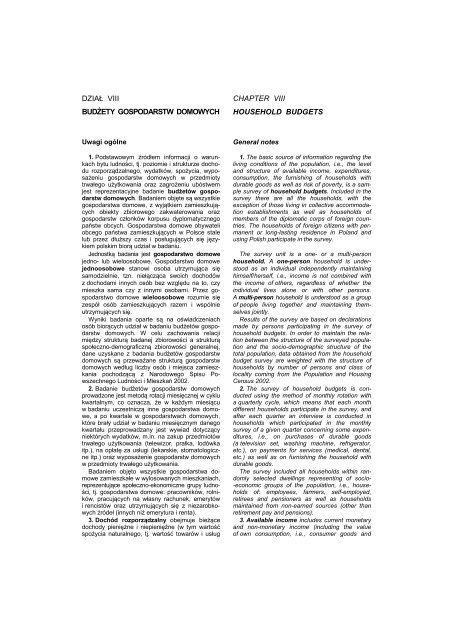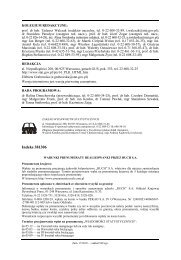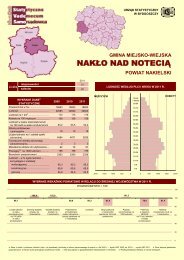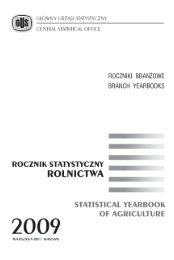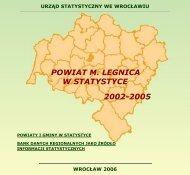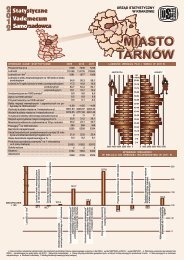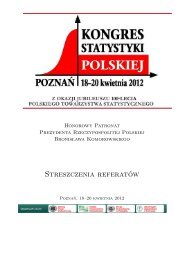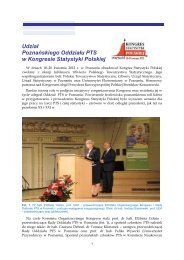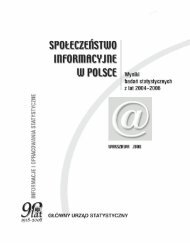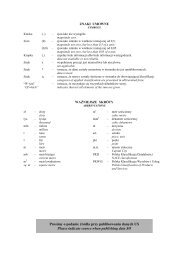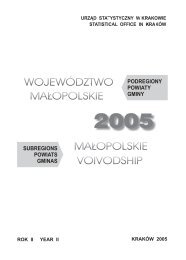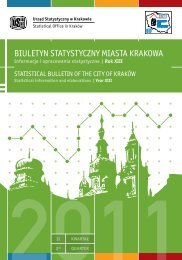Untitled - Główny Urząd Statystyczny
Untitled - Główny Urząd Statystyczny
Untitled - Główny Urząd Statystyczny
Create successful ePaper yourself
Turn your PDF publications into a flip-book with our unique Google optimized e-Paper software.
DZIAŁ VIII<br />
BUDŻETY GOSPODARSTW DOMOWYCH<br />
Uwagi ogólne<br />
1. Podstawowym źródłem informacji o warunkach<br />
bytu ludności, tj. poziomie i strukturze dochodu<br />
rozporządzalnego, wydatków, spożycia, wyposażeniu<br />
gospodarstw domowych w przedmioty<br />
trwałego użytkowania oraz zagrożeniu ubóstwem<br />
jest reprezentacyjne badanie budżetów gospodarstw<br />
domowych. Badaniem objęte są wszystkie<br />
gospodarstwa domowe, z wyjątkiem zamieszkujących<br />
obiekty zbiorowego zakwaterowania oraz<br />
gospodarstw członków korpusu dyplomatycznego<br />
państw obcych. Gospodarstwa domowe obywateli<br />
obcego państwa zamieszkujących w Polsce stale<br />
lub przez dłuższy czas i posługujących się językiem<br />
polskim biorą udział w badaniu.<br />
Jednostką badania jest gospodarstwo domowe<br />
jedno- lub wieloosobowe. Gospodarstwo domowe<br />
jednoosobowe stanowi osoba utrzymująca się<br />
samodzielnie, tzn. niełącząca swoich dochodów<br />
z dochodami innych osób bez względu na to, czy<br />
mieszka sama czy z innymi osobami. Przez gospodarstwo<br />
domowe wieloosobowe rozumie się<br />
zespół osób zamieszkujących razem i wspólnie<br />
utrzymujących się.<br />
Wyniki badania oparte są na oświadczeniach<br />
osób biorących udział w badaniu budżetów gospodarstw<br />
domowych. W celu zachowania relacji<br />
między strukturą badanej zbiorowości a strukturą<br />
społeczno-demograficzną zbiorowości generalnej,<br />
dane uzyskane z badania budżetów gospodarstw<br />
domowych są przeważane strukturą gospodarstw<br />
domowych według liczby osób i miejsca zamieszkania<br />
pochodzącą z Narodowego Spisu Powszechnego<br />
Ludności i Mieszkań 2002.<br />
2. Badanie budżetów gospodarstw domowych<br />
prowadzone jest metodą rotacji miesięcznej w cyklu<br />
kwartalnym, co oznacza, że w każdym miesiącu<br />
w badaniu uczestniczą inne gospodarstwa domowe,<br />
a po kwartale w gospodarstwach domowych,<br />
które brały udział w badaniu miesięcznym danego<br />
kwartału przeprowadzany jest wywiad dotyczący<br />
niektórych wydatków, m.in. na zakup przedmiotów<br />
trwałego użytkowania (telewizor, pralka, lodówka<br />
itp.), na opłatę za usługi (lekarskie, stomatologiczne<br />
itp.) oraz wyposażenie gospodarstw domowych<br />
w przedmioty trwałego użytkowania.<br />
Badaniem objęto wszystkie gospodarstwa domowe<br />
zamieszkałe w wylosowanych mieszkaniach,<br />
reprezentujące społeczno-ekonomiczne grupy ludności,<br />
tj. gospodarstwa domowe: pracowników, rolników,<br />
pracujących na własny rachunek, emerytów<br />
i rencistów oraz utrzymujących się z niezarobkowych<br />
źródeł (innych niż emerytura i renta).<br />
3. Dochód rozporządzalny obejmuje bieżące<br />
dochody pieniężne i niepieniężne (w tym wartość<br />
spożycia naturalnego, tj. wartość towarów i usług<br />
CHAPTER VIII<br />
HOUSEHOLD BUDGETS<br />
General notes<br />
1. The basic source of information regarding the<br />
living conditions of the population, i.e., the level<br />
and structure of available income, expenditures,<br />
consumption, the furnishing of households with<br />
durable goods as well as risk of poverty, is a sample<br />
survey of household budgets. Included in the<br />
survey there are all the households, with the<br />
exception of those living in collective accommodation<br />
establishments as well as households of<br />
members of the diplomatic corps of foreign countries.<br />
The households of foreign citizens with permanent<br />
or long-lasting residence in Poland and<br />
using Polish participate in the survey.<br />
The survey unit is a one- or a multi-person<br />
household. A one-person household is understood<br />
as an individual independently maintaining<br />
himself/herself, i.e., income is not combined with<br />
the income of others, regardless of whether the<br />
individual lives alone or with other persons.<br />
A multi-person household is understood as a group<br />
of people living together and maintaining themselves<br />
jointly.<br />
Results of the survey are based on declarations<br />
made by persons participating in the survey of<br />
household budgets. In order to maintain the relation<br />
between the structure of the surveyed population<br />
and the socio-demographic structure of the<br />
total population, data obtained from the household<br />
budget survey are weighted with the structure of<br />
households by number of persons and class of<br />
locality coming from the Population and Housing<br />
Census 2002.<br />
2. The survey of household budgets is conducted<br />
using the method of monthly rotation with<br />
a quarterly cycle, which means that each month<br />
different households participate in the survey, and<br />
after each quarter an interview is conducted in<br />
households which participated in the monthly<br />
survey of a given quarter concerning some expenditures,<br />
i.e., on purchases of durable goods<br />
(a television set, washing machine, refrigerator,<br />
etc.), on payments for services (medical, dental,<br />
etc.) as well as on furnishing the household with<br />
durable goods.<br />
The survey included all households within randomly<br />
selected dwellings representing of socio-<br />
-economic groups of the population, i.e., households<br />
of: employees, farmers, self-employed,<br />
retirees and pensioners as well as households<br />
maintained from non-earned sources (other than<br />
retirement pay and pensions).<br />
3. Available income includes current monetary<br />
and non-monetary income (including the value<br />
of own consumption, i.e., consumer goods and


